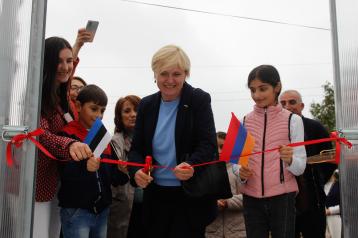Countries
The humanitarian conference organised by the Estonian Refugee Council brought together humanitarian experts and organisations from around the world in Tallinn yesterday. Now in its third year, the conference facilitated discussions on the need for institutional reform, the deepening funding crisis, digital transformation, and ways to support people in hard-to-reach areas.
Eero Janson, Director of the Estonian Refugee Council, emphasised the need for meaningful systemic change in the humanitarian aid sector. “When needs are growing but funding is shrinking, humanitarian organisations are faced with impossible choices – whom to help and whom to leave unaided. While improving efficiency is undoubtedly important and technological solutions can contribute to that, they alone cannot close the ever-widening gap between funding and needs. What is required is a fundamental rethinking of how the whole system functions and how its various parts cooperate – from the UN to the grassroots level,” Janson said.
In his opening remarks, Janson highlighted that against the backdrop of drastically reduced funding, more than 300 million people will need humanitarian assistance this year. In addition, over 123 million people have been forcibly displaced – the highest number of refugees in history. Meeting these needs would cost approximately 45 billion US dollars, which is only about half the annual net profit of a single tech giant such as Apple, Alphabet or Microsoft.
“There is no shortage of money in the world – but there is a shortage of justice, solidarity and the will to protect vulnerable people,” Janson stated. He called for reshaping the humanitarian aid sector in Estonia’s image – leaner, more efficient and more digital.
The first panel, Ctrl+Alt+Del. Rebooting the Humanitarian Action, featured Hans Das (DG ECHO), Reshma Adatia (ICVA) and Mervat Shelbaya (IASC Secretariat), who discussed what changes are needed in the face of the funding crisis and instability affecting the sector. The upcoming reform focuses on two key pillars: cash-based humanitarian assistance and support for local actors. The panel was moderated by Eero Janson (Estonian Refugee Council).
The second panel, Hack to the Future. Navigating Digital Humanitarianism, explored how digital technologies are transforming humanitarian assistance and what hinders cooperation and data sharing. While there are many digital tools, solutions often precede a clear definition of the problem. Efforts should focus on ensuring all organisations have access to open-source or open access digital tools, creating equal opportunities to use technology for more effective humanitarian work. Panellists included Patrick Vinck (Harvard Humanitarian Initiative, KoBo), Rory Crew (CaLP) and Danna Ingleton (HURIDOCS). The panel was moderated by Tobias Koch (CGI).
The final panel of the day, Access Denied? Navigating Aid Delivery in Hard-to-Access Areas, featured Tristan Ferraro (ICRC), Christopher Ghaiath Almajdoub (Estonian Refugee Council) and Hani Almadhoun (Gaza Soup Kitchen). The discussion focused on the conditions under which international law enables access to crisis zones and potential solutions where such access is restricted. When local markets are functioning, cash-based humanitarian assistance can offer a viable way to reach people even in active conflict zones. The sector needs organisations with different mandates and capacities to complement each other and work together. The panel was moderated by Michael Riepl (Academy for European Human Rights Protection).
For the first time, this year’s conference concluded with an open-mic session titled Failing Forward, where participants were invited to share their experiences of failure and the lessons learned. These stories encouraged honest self-reflection and learning from mistakes, helping both individuals and organisations to grow and develop.
More than 120 people attended the conference, which took place at Fotografiska Tallinn.
The event is supported by ESTDEV – the Estonian Centre for International Development.







